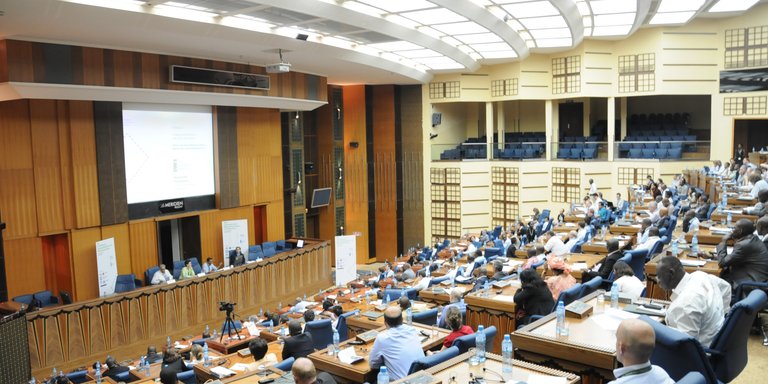
INSURESILIENCE -
Bringing together partners to scale up Climate and Disaster Risk Finance for the most vulnerable
An essay by Dr. Astrid Zwick, Delia Kaiser, Ines Maria Perez Martinez
properties.trackTitle
properties.trackSubtitle
INSURANCE IS A KEY ELEMENT FOR CLIMATE ADAPTATION
CAN A GLOBAL PARTNERSHIP FOR CLIMATE AND DISASTER RISK FINANCE HELP SOLVE THE PROBLEM?
The global landscape for Climate and Disaster Risk Finance and Insurance is fragmented, solutions are not always easily accessible or tailored to the specific needs of vulnerable countries. To address the challenges for the most vulnerable countries, collaborative and coordinated public and private efforts are needed. Through a grand coalition of over 110 members, the InsuResilience Global Partnership (‘InsuResilience’) is well structured to drive forward ambitious and transformative solutions to close the protection gap in the face of increasing climate volatility. It brings together industrialised and vulnerable countries, the private sector, multilateral organisations, civil society, academia and other networks and initiatives behind a common vision (Accordion 1).
To date, 22 InsuResilience programmes are active with over 300 projects in more than 100 countries (Accordion 2). In 2021 alone, these programmes provided climate and disaster protection for over 150 million poor and vulnerable people. Yet, transformative change is needed to significantly increase resilience. To date, InsuResilience has established impactful coalitions such as the Tripartite Agreement between the German Government, the United Nations Development Programme and the Insurance Development Forum (IDF) to develop tailor-made solutions in more than 20 vulnerable countries at sovereign level. Moreover, under the co-chairpersonship of the Microinsurance Network (MiN), AXA Group and InsuResilience, the IDF’s Inclusive Insurance Working Group, a group of more than 15 organisations – including the Munich Re Foundation – operating in different markets, is about to support sustainable insurance market development in more than 20 countries to protect individual policyholders. InsuResilience supported the establishment of the Sustainable Insurance Facility launched at COP26 for the protection of micro, small and medium-sized enterprises, initiated and owned by the Vulnerable 20 Group.
Main targets of the Insu- Resilience Global Partnership Vision 2025:
- 500 million poor and vulnerable people covered against disaster and climate shocks through pre-arranged risk finance and insurance mechanisms
- 150 million people covered by microinsurance
- 80 vulnerable countries with comprehensive disaster risk finance strategies in place
Support by InsuResilience programmes providing fast liquidity after disasters:
- AFRICAN RISK CAPACITY (ARC)
ARC is a sovereign risk pool to provide reliable, rapid financing in the event of droughts, tropical cyclones and other disasters. Since 2014, 62 policies have been signed by the Member States, providing up to US$ 720m of insurance coverage to be paid in the event of a covered loss. This has protected millions of vulnerable populations in participating countries, with actual payouts amounting to almost US$ 65m to facilitate post-disaster response.
- GLOBAL RISK FINANCING FACILITY (GRiF)
GRiF is a multi-donor trust fund which provides grants to test, pilot and scale up support to strengthen the resilience of vulnerable countries to climate and disaster shocks. GRiF activities include insurance premium financing, contingent financing, risk financing investments, technical assistance, and capacity building. Fast liquidity through payouts is provided in the case of disasters, as for example in 2021 in Indonesia with a US$ 14m grant to assist building technical capacity, environmental and social management systems.
The services offered by the InsuResilience Solutions Fund (ISF):
As one of the InsuResilience implementing programmes, the ISF is a product development facility designed to promote needs-based insurance products in developing countries and emerging economies, and to increase the financial protection of poor and vulnerable households against extreme weather events and disasters. The fund offers:
- Climate risk analysis for risk management and adaptation strategies
- Advice for the development of innovative insurance solutions
- Co-funding for the development and market introduction of new insurance products
In 2020 alone, the ISF signed five grant agreements to help develop new insurance solutions from Latin America to Southeast Asia, amounting to almost €6m.
COORDINATION, COLLABORATION AND CONVERGENCE ARE KEY TO SUCCESS
Managing climate risks necessitates looking at the full risk continuum, from risk prevention and risk reduction to risk transfer using Climate and Disaster Risk Finance instruments. However, the concept and the potential of these instruments are not well known and understood. Moreover, risk data and modelling is a prerequisite and constitutes another gap for comprehensive climate risk management at national level. Capacity needs to be developed to select the most efficient instrument for each type of risk for each region. So-called “Economic Costs of Adaptation” studies, for example offered by the InsuResilience Solutions Fund (Box 3), could support a country’s resilience building. Innovative approaches such as index insurance could be applied if the data situation allows. However, a comprehensive climate risk strategy demands a broad range of knowledge and experience, the collaboration of multiple actors, good coordination of various services offered and ultimately a convergence among a still fragmented climate risk community.
Against this backdrop, InsuResilience has developed guidance and standards such as the Pro-Poor Principles and the Principles for SMART Premium and Capital Support. It has established a Centre of Excellence on Gender-smart Solutions in Climate and Disaster Risk Finance to mainstream the gender dimension into these solutions. A recently developed action plan in collaboration with UNFCCC sets out five elements for Climate and Disaster Risk Finance integration in the nationally determined contributions (NDCs) and a diagnostic tool has been developed to identify entry points for Climate and Disaster Risk Finance in National Adaptations Plans (NAPs).
In the spirit of collaboration, the International Conference on Inclusive Insurance organised by the Munich Re Foundation and Microinsurance Network offers a great knowledge-sharing platform and an opportunity for a space connecting insurance solutions at sovereign and community level.
WHAT COMES NEXT?
*******************************************************
.jpg/_jcr_content/renditions/crop-1x1-768.jpg./crop-1x1-768.jpg)
Insurance solutions are elementary components of sustainable climate adaptation strategies.

